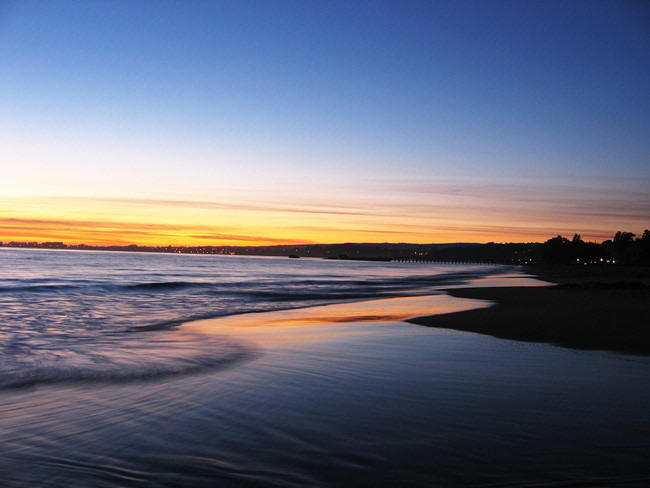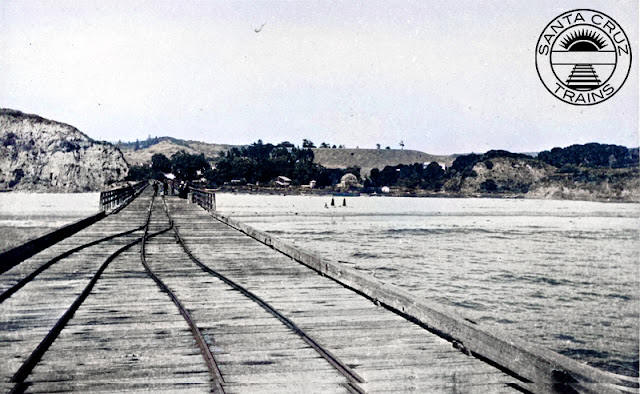
Seacliff History

The Ohlone Indians thrived for thousands of years on the area’s natural resources. The riches of the ocean, rivers, and forests provided plentiful sources of food—from fish, shellfish, and game to edible plants and seeds. Their numbers were severely reduced by illness and cultural changes brought to California by European settlers, yet some Ohlone descendants continue their ancient traditions and crafts today. Spanish colonization led to the establishment of Mission Santa Cruz. After Mexico broke away from Spain in 1821, the land was subdivided into Mexican land grants (ranchos).
In 1833 the government of Mexico granted Aptos Rancho to Rafael Castro. The port facilitated major trade with the Kingdom of Hawaiʻi. In 1838, King Kamehameha III requested that Mexican vaqueros from California travel to Hawaiʻi to teach Hawaiians how to manage herds of wild cattle. Seacliff became a popular place to recruit vaqueros, who were known as paniolos by the Hawaiians. In the 1850s, Thomas Fallon acquired part of the beach and turned it into a resort, which he named "New Brighton", in honor of his favorite seaside resort in England.
By 1872, Claus Spreckels, the sugar millionaire, began buying the land from Castro including Seacliff. Throughout the latter half of the 19th century, much of Aptos was owned by Spreckels, who some historians have pinned as the most successful German-American immigrant businessman of the 19th century. An entrepreneur who built and broke monopolies in the sugar, railroad, banking, newspaper and beer brewing industries, Spreckels owned nearly all of southern Santa Cruz County where he raised some of the finest thoroughbred horses of his day. Four years after Spreckels took title to Castro's wharf (a wharf that stretched from Aptos Creek near Rio del Mar and Seacliff toward the sea), Congress drafted the reciprocity treaty that allowed certain Hawaiian imports to enter the country duty free. Sugar was among these commodities, and Spreckels dominated the sugar market in California, importing sugar from his own plantation in Hawaii. Spreckels owned the state's only major sugar refining plant in San Francisco, known as Bay Sugar Refining Company. He essentially had a monopoly on the refining of Philippine and Hawaiian sugar, Seacliff developed into a bustling shipping port with the building of the Castro-Spreckels wharf expanded to over 1,000 feet in length. The logging industry also thrived here with the local coast redwood trees.

Aptos Wharf and Aptos c. 1882. Taken during the Spreckels era looking north, this rare photo shows the sandstone bluff that is part of today's Seacliff State Beach. The treeless hills in the distance are what we now call Aptos Village, while the buildings to the fight of the wharf are part of Spreckel's Hotel complex. The railroad tracks on the wharf were used to move cargo on small horse-drawn railcars. No locomotives ever came out on the wharf.
The Santa Cruz Land and Title Company surveyed the Seacliff area, naming it “Seacliff Park,” including the area in Seacliff Village, laying out lots and streets. Although never developed, these lots and streets are very close to today’s configuration of lots and streets.
Times changed for Spreckels in 1886, when he fell from grace with the Hawaiian royal court. Cut off from his sugar supplies, Spreckels had to find an alternative product or lose his market monopoly. His salvation came in the form of new technology. Spreckels was the first to commercially produce sugar from sugar beets. And, he paid area farmers to grow sugar beets to ship to his Watsonville Sugar Refinery. By 1886, the Aptos wharf was no longer needed in Spreckel's plans. The ocean quickly knocked off sections of the neglected wharf so that by 1889 it was only 600 feet long. By the turn of the century only the occasional fisherman used it, and soon thereafter it collapsed. A new pier would be built further north on Seacliff Beach in 1930.
When he died in 1908, Fred Summers, a Pomona businessman, bought a huge swath of property in what is now Aptos with an idea of developing the real estate for wealthy San Francisco people who wanted a seaside spot or those looking to live full time beside the Monterey Bay, Before the 1920′s, the land near Seacliff was used for pasture and sugar beet production. In 1925 and 1926, the Seacliff Company of Santa Cruz prepared a development plan for Seacliff Beach and the coastal plateaus above it. During the mid-1920s, landowners built summer homes on the bluffs above Seacliff and the area to its south, Rio del Mar. On the north side of Seacliff, 1920s tourists enjoyed upscale camping facilities. Seacliff became one of California's first state beaches in 1931. The Seacliff Corporation proposed a clubhouse, a large auditorium, a breakwater, a hotel, and a residential subdivision. It also wanted to build a gigantic pier into the ocean to provide the entertainment component to their development. The only problem being that every time they built a pier, it was destroyed by sea swells and storms. Later on, the corporation decided to buy a ship and have it outfitted as a casino. The area within the Seacliff Village was developed mostly in the second half of the 20th century.
The beach is home to many types of birds and marine life, including mussels, ocean worms, sea stars, sea anemones, barnacles, rock crabs, harbor seals, anglers, flounder, mackerel, halibut, lingcod, perch, cabezon, jacksmelt, steelhead, anchovy, bocaccio (tomcod), kingfish, dark seabirds, sea lions, dolphins, harbor seals, sea otters and whales. The Palo Alto serves as a main place for marine life.